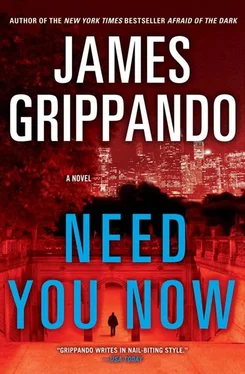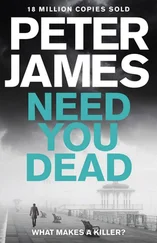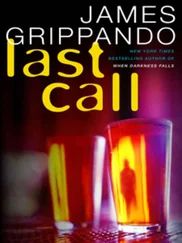Evan Hunt was definitely no nut job.
Andie stepped closer to the wall near the kitchenette. She was following a long yellow line that had puzzled her all night. It started near the bathroom, rose up and over the closet that held Evan’s collection of orange dress shirts, and continued down the other side of the wall. There were various forks in the line along the way, but the main thread ran to a small, hand-drawn rectangle just above the baseboard near the kitchenette. It was no bigger than a standard index card. Inside the rectangle was a list of dates, all from the same period of time: the last six months of Gerry Collins’ life.
Andie stepped back again for a broader view. She knew the dates had to be important, falling so close to Collins’ murder and Cushman’s collapse. But the rectangle contained no other information, and the dates bore no apparent relationship to the surrounding clutter of information on the wall. The long yellow line that stretched halfway across the room also suggested that the dates were significant, but it connected the rectangle to nothing.
“Last call for food,” the detective announced. “You change your mind yet, Henning?”
“No, I’m okay,” she said.
“One of us dumb locals can help you decode the menu, if that’s the problem.”
Clearly, he fancied himself a smooth operator, and when all else failed, there was self-deprecation. “I got the sequence,” said Andie. “Four, two, three-”
She stopped herself in midsentence, and she remembered what he had said earlier about the screwed-up menu.
The hostess said it happens all the time. It’s become a running joke-kind of a signature of their takeout business. The regulars dig it.
There were four pages in the “signature” menu. Four walls in Evan’s flowchart. Andie turned and faced the flowchart again. She’d studied that rectangle long enough, looked at it from enough different angles, to recall where it fell in the seemingly endless sequence of squares, rectangles, circles, ovals and other hand-drawn shapes in Evan’s narrative. It was a hunch, but Evan was a quant, and numbers were his entertainment. She counted again, just to make sure, and her hunch proved to be correct. The little rectangle that had seemed so randomly placed, that contained such an important list of dates, that was tethered to a long yellow line that led to nowhere, was indeed the fourth rectangle on the wall.
Turning clockwise in the center of the room, Andie shifted her gaze to the next wall. Following the pattern-four, two, three, one-she located the second rectangle on the wall. This one, too, seemed out of context, though the information in it didn’t cry out for Andie’s attention the way the dates had. There was no reason to notice it, unless she was following the pattern. It contained the names of several business establishments-Precious Jewelry Exchange, Discount Diamonds, and the like. She jotted down the names on a notepad, then turned and faced the next wall.
Andie found the third rectangle just above the baseboard. Like before, the information inside the rectangle bore no relationship to the information around it. Andy recognized it as a list of towns and regions in Singapore: Woodlands, Bedok, Hougang, Jurong West, and Bukit Merah. Andie scribbled them all into her notepad next to the dates and the list of businesses.
Finally, Andie faced the fourth wall, which was the one with the papered-over window. The first rectangle-the last in the four, two, three, one sequence-was enormous in comparison to the others. The wall was basically a person-by-person profile of key players in the Cushman fraud.
Rectangle number one was all about Gerry Collins.
Andie reread her notes. Four, two, three, one. It only seemed logical that each date in rectangle number four marked a business transaction of some sort. She’d investigated enough financial crimes to sniff out bogus transactions, however, and she noted that each establishment identified by name in rectangle number three appeared to be in a line of business that lent itself to the creation (fabrication) of big invoices-tens or even hundreds of thousands of dollars a pop. Rectangle number two confirmed that the businesses operated in Singapore, not exactly a model state of tight financial regulation. And it all went back to rectangle number one in the cast of characters: Gerry Collins. Phony business transactions were one way to launder the fruits of criminal activity, and it was no leap of logic to conclude that jewelry invoices from Singapore that bore Gerry Collins’ fingerprints-actual or virtual-were probably fakes.
Four, two, three, one.
It happens all the time. It’s become a running joke-kind of a signature of their takeout business.
Of all the ingenious codes that a math whiz could have devised to stop a stranger from breaking into his apartment and uncovering key information in his Cushman flowchart, Evan Hunt had simply borrowed the pattern established by the consistently screwed-up pagination of the takeout menu from the Chinese restaurant below him. Evan was one of the regulars who liked the “running joke.” It was as if he was making fun of every movie, every TV show, every book that had ever strained to find “codes” in meaningless number sequences. The quant had a sense of humor.
Who knew?
Andie stepped back from the wall, and the broader perspective confirmed her hunch: There was indeed no line of any color connecting these 4-2-3-1 boxes to Cushman. Andie was beginning to feel the excitement of a multibillion-dollar lead on missing investment funds-funds that, she suspected, Gerry Collins had never actually fed to Cushman.
She went into the bathroom and closed the door, then dialed the number of a colleague she had worked with on another financial crimes investigation. He worked in the Office of Law Enforcement Support at FinCEN-the Financial Crimes Enforcement Network-and she didn’t have to remind him that he owed her a favor or two.
“Andie, hey, it’s good to hear from you.”
“Sorry to call so late,” she said.
“No problem. How can I be of help?”
“I’ve come across the names of a few business establishments in Singapore, and I was hoping that you could check to see if any have shown up on your radar screen.”
“You mean in suspicious-activity reports?”
“Not exactly.”
Andie paused, knowing that she had to be careful, since the plug had been pulled on her investigation. What she wanted was some very specific information about the oldest informal banking system in Southeast Asia. One that often operated as a side business to jewelry stores, rug dealers, and other going concerns in local communities from New York to Karachi, from London to Dubai. A $300 billion-a-year system that relied on an unregulated global network of personal relationships and trust, and that involved no actual exchange of money or formal record keeping-definitely nothing electronic. Unrecorded conversations were king-conversations in Arabic, Hindi, Urdu, Gujarati, and Farsi.
For Andie’s present needs, English would do, and it was perhaps best to speak in generalities.
“I want to talk to you about hawalas ,” she said. “ Hawalas in Singapore.”
I couldn’t sleep. The air mattress was plenty comfortable, but my mind would not shut off. Scully’s snoring didn’t help.
I got up quietly, tiptoed to the kitchen, and raided the refrigerator. There was one slice of pizza left over from dinner, and it had my name on it. I brought the Gino’s box to the table and pulled up a chair. Connie’s PC was humming on the counter, and the only light in the kitchen was the dim glow of the screen saver on the LCD. Snow monkeys.
Читать дальше












